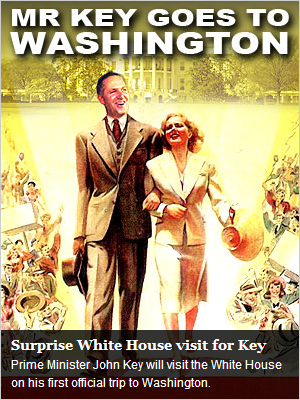It’s hardly the stuff of rigorous historico-social investigation, but Simon Schama sees much to celebrate in NZ biculturalism — particularly in comparison to our Anglo comparators:
But it’s the story of Maori and pakeha, the settlers of European origin, that – for all the pain, betrayals and suffering – still deserve to be known and celebrated as offering a different model of cultural encounter than anywhere else in the world. […] Of course there have been serious problems of unequal social opportunity, of street gangs. But if there is anywhere in the post-colonial world where two cultural worlds truly live an engaged life alongside each other, it’s in New Zealand.
Such stories don’t come along very often. Cherish them. Chant them. Dance them.
Upane upane, kaupane, whiti te ra! Up the ladder, up the ladder, the Sun Shines.
This is broad-brush stuff, and minimises the genuine grievance and disquiet which exists on both sides of the cultural divide — his “divided no longer” caption to a stock photo is altogether too pat. And his assessment of Paul Holmes as a “tough” and “a reproach to dozy thinking” is marginal at best. But Schama’s observation that what we have in this country is quite unlike any other postcolonial nation is exactly right. It provides a glimpse at what might have been been elsewhere, and what might have been here if the post-Treaty settlement had been undertaken in better faith.
This raises a question Pablo and I discussed in email after he wrote this post (I didn’t want to hijack the excellent discussion there): do those who hate and fear Tino Rangatiratanga and consider the Treaty a “simple nullity” really believe that the people of Aotearoa — of all colours — would be better off if the typical colonial counterfactual were true — if Hobson’s marines and settlers had simply driven the natives into the sea or exterminated them as animals? In my email to Pablo, I wrote:
I’ve often argued (as a wind-up or a devil’s advocate position) that the MÄori are ungrateful whingers who don’t appreciate what an incredibly good deal they got from Hobson, and that NZ would have been better off if Europeans had just landed with boatloads of armed soldiers and done to the natives what they did in the rest of the world. Anything for a peaceful life. What’s interesting is that, even when discussing the topic with people who genuinely believe that the Treaty is a gravy train and the natives are taking the piss and actually are ungrateful, they generally balk at this suggestion. That consent [given by the colonised to the colonisers], however fraught and limited, is important to how we see ourselves. That’s one of the reasons I’m generally pretty hopeful about the bicultural future.
I expressed somewhat similar views in comments to this post of Chris Trotter’s a short time later. Neither Chris, nor the other commenter to that post (RedLogix, with whom I’ve had robust but usually cordial disagreements on this topic) responded to my comments, which I took as a sort of confirmation of my thesis.* As I say, this is the usual response to the argument I’ve made many times before — all but the most unrepentant rednecks are repelled by the view that colonialism NZ-style was worse than what might have happened if we’d undertaken it Australian-style. This indicates to me that even for those who are highly critical of it grudgingly accept that the Tino Rangatiratanga movement, Waitangi Tribunal and attendant concessions to MÄori in our political and social systems are better than the counterfactual alternative of a white monoculture in the South Pacific, even if it were more peaceful. The importance of this for a bicultural future is profound.
L
* I don’t want to put words in Chris and RL’s mouths, though — it may be that they simply thought my remarks too ridiculous to bother engaging with. Happy to accept clarification on this point.
(Schama article via Tim Watkin at Pundit. Thanks! And as it happens, Idiot/Savant at No Right Turn has excerpted it as well.)

